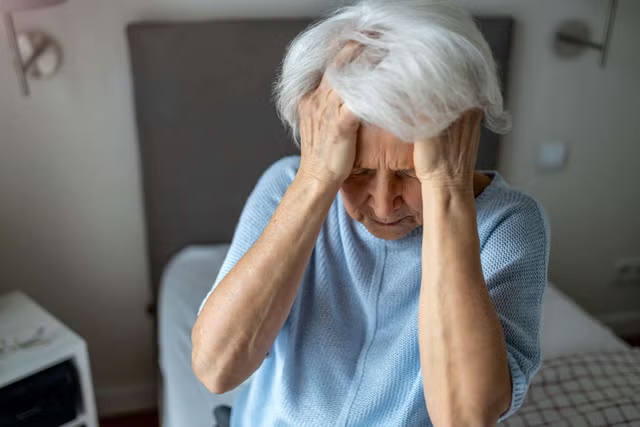Your support helps us to tell the story
Support NowThis election is still a dead heat, according to most polls. In a fight with such wafer-thin margins, we need reporters on the ground talking to the people Trump and Harris are courting. Your support allows us to keep sending journalists to the story.
The Independent is trusted by 27 million Americans from across the entire political spectrum every month. Unlike many other quality news outlets, we choose not to lock you out of our reporting and analysis with paywalls. But quality journalism must still be paid for.
Help us keep bring these critical stories to light. Your support makes all the difference.
For many women who experience debilitating menopausal symptoms, HRT (Hormone Replacement Therapy) can be a saving grace.
HRT is known for relieving most perimenopause and menopause symptoms, such as night sweats and low mood, however it does have some risks.
To mark World Menopause Day on Friday, we have spoken to some experts who have explained exactly what HRT is, who it is suitable for and what types of treatments are available.
What is HRT and how does it work?“HRT replaces the hormones that the ovaries were producing so that the symptoms and effects of menopause are minimised,” explains Dr Claire Phipps, GP and British Menopause Society (BMS) menopause specialist at London Gynaecology. “In addition, to reversing troublesome symptoms of menopause and improving quality of life, HRT also helps with the prevention of osteoporosis (thinning of bones) and cardiovascular events such as heart attacks.“Modern HRT consists of body-identical hormones, delivered through the skin and orally, and are very effective for treating a collection of symptoms and also providing long-term health benefits for women’s hearts and bones.”
There are two types of HRT. The type you take depends on where you are in the menopause, and if your periods have stopped completely for a year.
“Oestrogen-only HRT is used if you have had surgery to remove your womb (a hysterectomy) or use an IUS (intrauterine system),” explains Dr Elise Dallas, women’s health GP and menopause specialist at London Gynaecology. “And combined HRT is used if you still have your womb.”Is HRT suitable for everyone?“HRT isn’t suitable for everyone,” highlights Dr Samantha Wild, women’s health clinical lead at Bupa Health Clinics. “People who have certain medical conditions, for example, breast cancer, or are having tests for breast cancer may be advised not to have it.
“Similarly, those who have undiagnosed vaginal bleeding will need to be investigated first.
“Your GP will review your medical history to determine what is right for you, and if necessary, you may need to see a menopause specialist.”
Here are the different types of HRT treatments…Tablets
Tablets are one of the most common forms of HRT and both oestrogen-only and combined HRT are available as tablets, according to the NHS website.
You usually take them once a day.Patches
HRT patches are a common way to treat menopause symptoms by releasing hormones into the body through the skin.
“You must change the patches twice a week to give your body a steady supply of hormones,” says Dallas. “There is enough hormone in each patch to last for several days.
“The adhesive side of the patch should be applied to a clean, dry, unbroken, non-irritated area of skin below the waist on the abdomen, on the lower back, thigh or buttocks.”
These patches must not be applied on or near the breasts orput it on top of cuts, spots or anywhere the skin is irritated.
Also Dallas urges women to not use cream, moisturiser or talc before applying the patch, or to apply the patch on the same area of skin twice in a row.
Gels and sprays
You can rub the gels onto your skin twice every day, or spray one to three sprays onto the inner side of your arm daily. “The gels and spray needs to be applied at the same time every day, usually when getting up and dressed or when going to bed,” says Dallas. “You should avoid the application of moisturiser or sunscreen to the area within one hour of application of your gel or spray.
“If you split your dose of gel or spray into a morning and evening application, leave about 12 hours between doses, if you can.”
Creams
“Cream is applied inside the vagina or around the outside to help with symptoms such as vaginal dryness,” explains Wild.
Implants
“Implants are usually inserted in the abdomen or bottom every six to eight months,” says Wild. “They are not commonly used as they are unlicenced for use in the UK but may be used by some specialists.”
Vaginal rings
“Vaginal rings are applied inside the vagina to help with symptoms such as vaginal dryness,” notes Wild.
Pessaries
“These are applied inside the vagina to help with symptoms such as vaginal dryness,” explains Wild.
How do you know which type is right for you?
“The type of HRT is really personalised to the individualised symptoms that you are having, what stage you are in menopause, whether you’ve had a hysterectomy and your personal preference on how you like taking medication,” explains Wild. “For example, if someone is suffering most with vaginal dryness, then a vaginal cream, pessaries or ring may be more suitable, and can be used alongside HRT.
“Speak to your GP about your symptoms and together you can work out which will be the best type for you.
“You may need to try different types and doses to find what suits you best.”
Disclaimer: The copyright of this article belongs to the original author. Reposting this article is solely for the purpose of information dissemination and does not constitute any investment advice. If there is any infringement, please contact us immediately. We will make corrections or deletions as necessary. Thank you.



